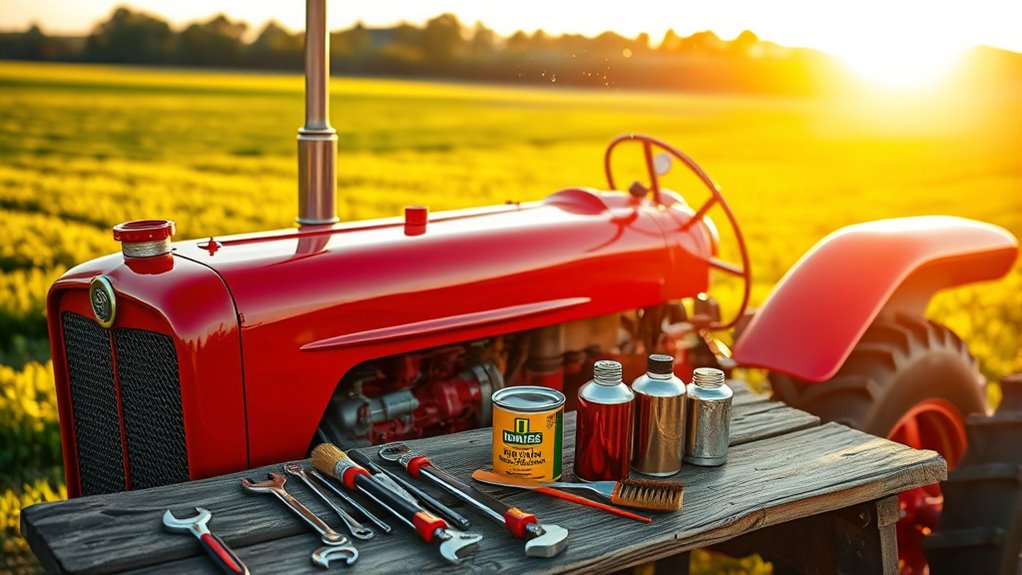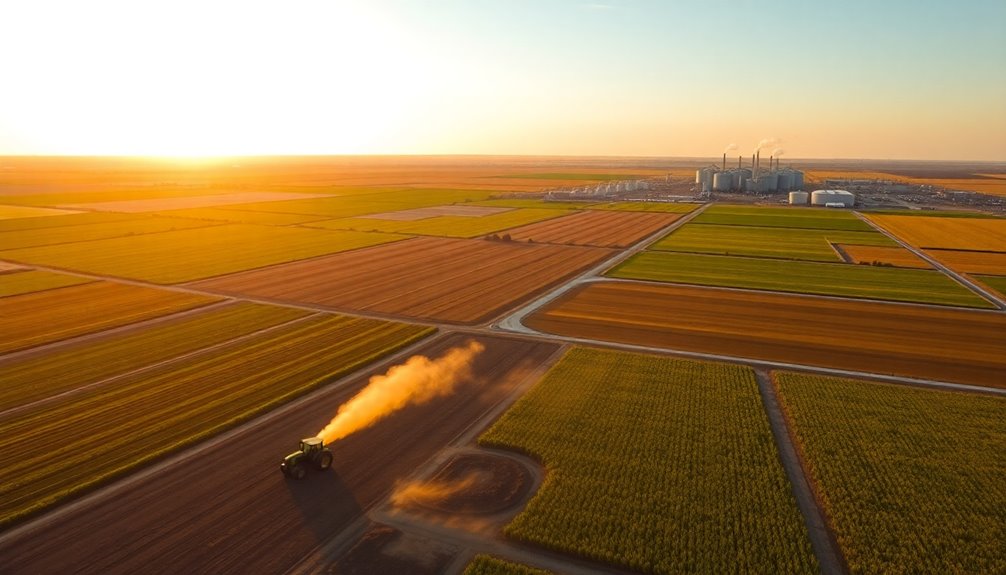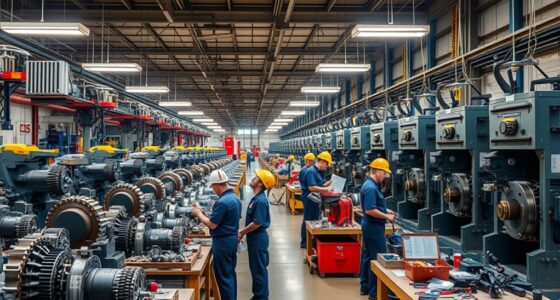To keep your tractor running smoothly, start by reading the owner's manual for maintenance guidelines. Regularly refill coolant and change the oil every 100-150 hours. Don't forget to check tire pressure and inspect them for wear. Maintain the hydraulic system by checking oil levels and replacing filters as needed. Finally, verify the electrical system is in good shape by inspecting battery terminals and cables. There's more you can learn to enhance your maintenance routine.
Key Takeaways
- Regularly consult the owner's manual for specific maintenance guidelines and schedules to ensure optimal tractor performance.
- Check and maintain coolant and oil levels to prevent overheating and engine damage, changing oil every 100-150 hours.
- Inspect tire pressure and condition frequently, adjusting pressure for different tasks and ensuring even wear through regular rotation.
- Maintain the battery and electrical system by checking connections, cleaning terminals, and replacing faulty components to avoid starting issues.
- Document all maintenance and repairs in the owner's manual to keep a comprehensive service history and track performance over time.
Read Your Owners Manual
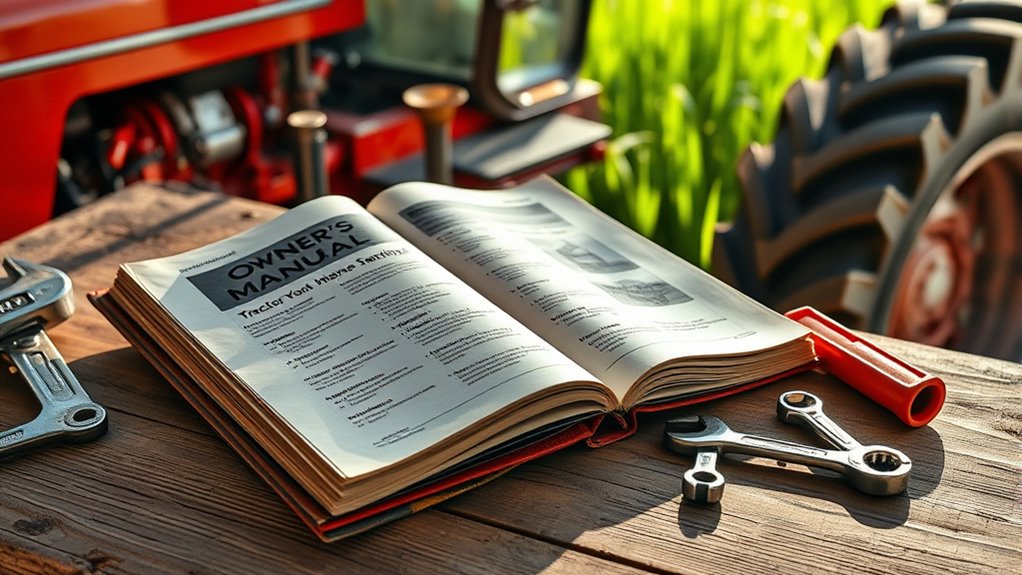
When you get your tractor, the first thing you should do is read your owner's manual. This vital guide provides maintenance guidelines, including recommended service intervals and product specifications for optimal performance.
Keeping the owner's manual accessible allows you to quickly reference maintenance tasks, ensuring you don't overlook anything during regular maintenance checks. It also outlines important safety operation details and troubleshooting tips, helping you avoid costly mistakes.
Having your owner's manual handy enables swift access to maintenance tasks and crucial safety information, preventing costly oversights.
Make it a habit to check the engine regularly and document repairs and maintenance activities in the manual. This practice helps you track your tractor's history and informs future service decisions.
Plus, understanding the manufacturer's recommended tire pressure levels is essential for safe operation and extending tire lifespan.
Refill Coolant

Maintaining the right coolant level in your tractor's radiator is essential for preventing engine overheating and potential damage. Regularly check the coolant level, as it can deplete due to evaporation or leaks. If it's low, refill it using the recommended antifreeze and water mixture to guarantee peak engine performance. Always secure the radiator cap after refilling to prevent leaks and maintain pressure. Keep an eye out for any pooling liquids under your tractor, which may indicate a coolant leak that needs immediate attention.
| Action | Importance |
|---|---|
| Check coolant level | Prevents engine overheating |
| Refill coolant | Guarantees peak performance |
| Secure radiator cap | Maintains system pressure |
Change Oil
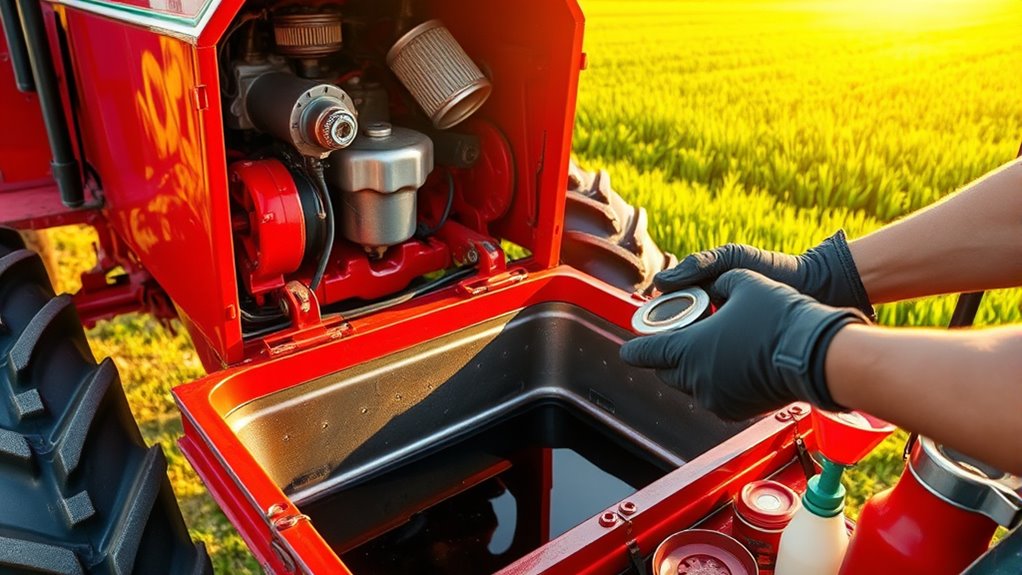
Changing your tractor's oil regularly—ideally every 100-150 hours of operation—is crucial for preventing engine wear and guaranteeing smooth performance.
To effectively change the engine oil, follow these steps:
- Check the engine oil level with the dipstick. Look for color and consistency; dirty or sludgy oil means it's time for a change.
- Change the oil filter simultaneously to maintain oil cleanliness and peak engine performance.
- Use the manufacturer's specifications for oil type to keep your warranty valid and assure compatibility with your tractor.
Don't forget to document oil changes in your owner's manual.
Keeping track of your maintenance history helps you stay organized and guarantees your tractor runs efficiently for years to come.
Check Tire Pressure & Condition

Checking your tire pressure and condition is essential for keeping your tractor running smoothly.
Use a tire-pressure gauge to guarantee your tires meet the manufacturer's recommended levels, and inspect them for any visible damage or wear.
Maintaining proper tire pressure not only enhances performance but also extends the lifespan of your tires.
Proper Tire Pressure
Proper tire pressure is essential for your tractor's performance and safety. Regularly checking tire pressure using a gauge helps guarantee it meets the manufacturer's recommended values. Incorrect pressure can reduce fuel efficiency and increase tire wear.
Follow these steps to maintain ideal tire pressure:
- Check tire pressure before each use, adjusting for specific tasks—lower for tilling and higher for paved roads.
- Inspect tires for visible wear, damage, or foreign objects to keep them safe and efficient.
- Rotate tires regularly to guarantee even wear, which can extend their life and improve overall performance.
Inspect Tire Condition
Maintaining tire pressure is just the first step in ensuring your tractor operates effectively. You should regularly check tire pressure with a gauge to match the manufacturer's recommended values.
Next, inspect tires for signs of wear and damage, like cracks or bulges, which can affect safety and efficiency. Adjust tire pressure according to specific tasks—lower it for tilling to boost traction and raise it for paved roads to enhance fuel efficiency.
If you notice uneven tire wear, it might signal alignment issues that need prompt attention. Keeping tires in good condition not only improves gas mileage but also extends their lifespan, which is a key point in your tractor maintenance guide.
Regular checks help maintain peak performance on the field.
Hydraulic System Maintenance
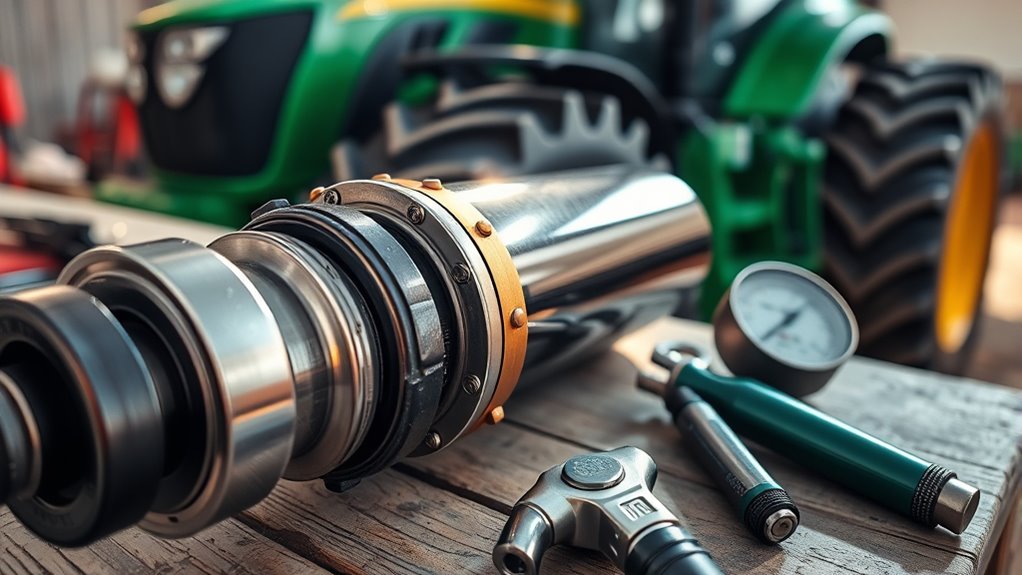
To keep your tractor's hydraulic system running smoothly, you need to regularly check the hydraulic oil levels and replace filters as needed.
Don't forget to inspect the hydraulic hoses for any signs of wear or leaks.
Staying on top of these tasks will help guarantee efficient performance and prevent costly repairs.
Check Hydraulic Oil Levels
Checking hydraulic oil levels is essential for keeping your tractor's hydraulic system running smoothly.
Regular monitoring guarantees peak performance and prevents costly repairs. Here's how to do it effectively:
- Use the dipstick or sight glass: Regularly check hydraulic oil levels to verify they're within the manufacturer's recommended range found in the operator's manual.
- Maintain cleanliness: Confirm your hydraulic oil is clean and free of contaminants; dirty oil can harm system efficiency.
- Top up carefully: Add hydraulic oil as needed, but avoid overfilling to prevent foaming, which can reduce system effectiveness.
Following these steps will help maintain your tractor's hydraulic system, assuring safe and efficient operation.
Don't forget to follow the service schedule for hydraulic filter replacements, too!
Inspect Hydraulic Hoses
Hydraulic hoses are essential for your tractor's operation, so you should inspect them regularly for any signs of wear and damage.
Look for cracks, fraying, or bulging, as these can lead to leakage and compromise your hydraulic system's efficiency.
Don't forget to check all hydraulic connections for tightness; loose fittings can cause pressure loss and system failure.
Additionally, monitor the hydraulic oil level and quality, since low or contaminated oil can negatively impact the performance of your hydraulic hoses and components.
If you notice significant wear or damage, replace those hoses immediately to maintain peak functionality.
Always refer to your tractor's owner's manual for specific guidelines on inspection and replacement intervals to guarantee proper maintenance.
Replace Hydraulic Filters
After guaranteeing your hydraulic hoses are in good condition, it's time to focus on another key component of your hydraulic system: the filters.
Regularly replacing hydraulic filters is vital for maintaining system cleanliness and efficiency. Follow these steps to guarantee proper filter maintenance:
- Check your maintenance schedule: Generally, replace hydraulic filters every 200-300 hours of operation, or as specified in your owner's manual.
- Use OEM specifications: Always choose replacement filters that meet OEM specifications to maintain compatibility and performance.
- Inspect for contaminants: During routine checks, look for signs of clogging or damage on the filter, which can indicate deeper issues within the hydraulic system.
Don't forget to dispose of old filters responsibly, as they may contain harmful contaminants.
Electrical System Maintenance
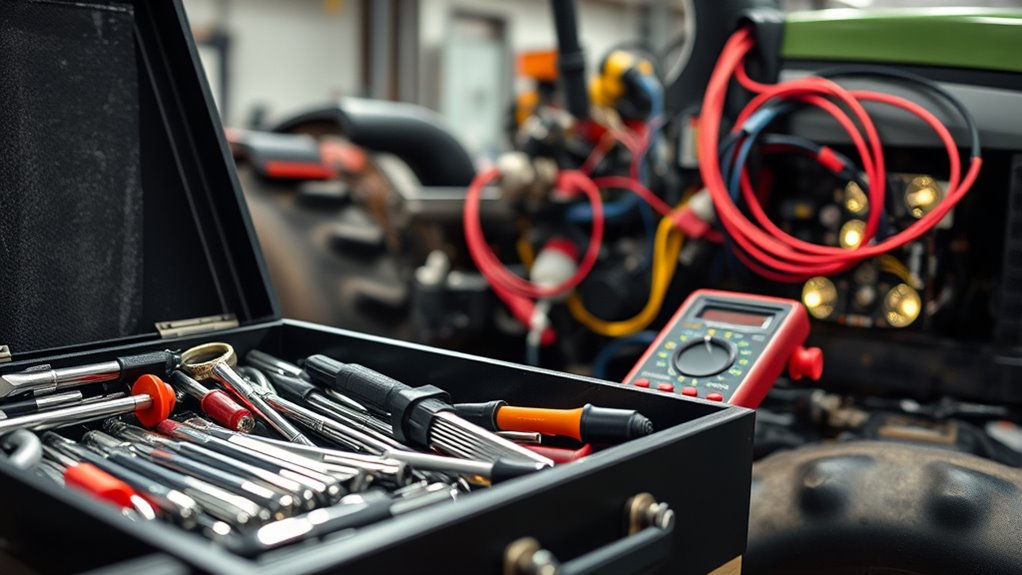
Since the electrical system is vital for your tractor's performance, regular maintenance is necessary to keep everything running smoothly.
Start by checking the battery water level frequently and topping it up as needed to guarantee peak performance and longevity. Clean the battery terminals to prevent oxidation, which can hinder electrical flow and lead to starting issues.
Regularly check the battery water level and clean terminals to ensure optimal performance and prevent starting issues.
Inspect all electrical cables for signs of wear or damage, and repair any loose or frayed cables to maintain safety and functionality.
Don't forget to check the fuses regularly; blown fuses can disrupt critical functions like lighting and starting.
Frequently Asked Questions
What Is the Routine Maintenance of a Tractor?
Routine maintenance of a tractor involves several key tasks.
You should check the engine oil, hydraulic fluid, tire condition, and coolant levels daily to guarantee everything runs smoothly.
For every 50 hours of operation, change the engine oil and filter, inspect the battery fluid, and clean the radiator screen.
At 100 hours, grease lubrication points and check the air filter.
What Is the Maintenance Required for a Tractor?
To keep your tractor running smoothly, you'll need to perform regular maintenance.
Start with daily checks of the engine oil, coolant, and tire condition.
Every 50 hours, change the oil and filter, inspect the battery, and clean the radiator screen.
At 100 hours, repeat those tasks, check battery fluid, and grease all zerks.
After 200 hours, change all filters and maintain the window washing system.
Don't forget professional service at 500 and 1000 hours!
What Are the Basics of a Tractor?
A tractor's your essential ally on the farm, designed to tackle heavy loads and various tasks.
You'll find they come equipped with multiple attachments like plows and mowers, allowing you to switch gears easily.
Built for tough terrains, their large tires provide stability and traction.
Modern tractors often feature advanced technology, including GPS, which helps you improve efficiency and monitor performance, ensuring you get the most out of your farming equipment.
What Are the 6 Common Preventive Maintenance Checks for Equipment Maintenance and Calibration?
When you think of preventive maintenance, picture a well-oiled machine running smoothly.
To keep your equipment in top shape, check the engine oil and filter regularly. Inspect tire pressure for safety and efficiency, monitor hydraulic oil levels, and guarantee your electrical system's battery and terminals are clean.
Don't forget to inspect fluid levels, belts, and hoses to catch potential issues early. These six checks can save you from costly repairs down the road.
Conclusion
In the grand saga of tractor maintenance, you're the heroic champion! By diligently reading your owner's manual, refilling coolant, changing oil, and checking tire pressure, you're not just keeping your tractor running; you're ensuring it'll conquer fields for ages! With proper hydraulic and electrical system care, you're practically bestowing immortality upon your machine. So, don't just maintain your tractor—elevate it to legendary status! Embrace your role, and watch your trusty beast thrive like never before!

